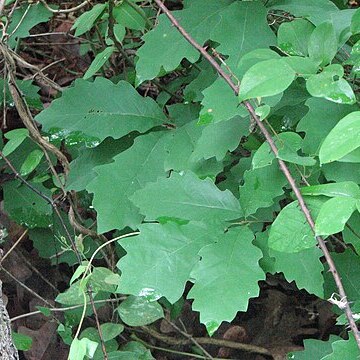Shrubs , deciduous, (0.5-)1-3(-5, 10?) m, sometimes spreading-rhizomatous. Bark gray, thin, flaky to papery. Twigs brownish, 1.5-3(-4) mm diam., sparsely fine-pubescent, soon becoming glabrate, graying in 2d year. Buds brown to red-brown, subrotund to broadly ovoid, 1-3 mm, apex rounded, very sparsely pubescent. Leaves: petiole (7-)8-15(-25) mm. Leaf blade lanceolate to oblanceolate or usually obovate, 40-140 × 20-60(-80) mm, leathery, base truncate to cuneate, margins regularly undulate, toothed or shallow-lobed, teeth usually acute, sometimes rounded, or acute-acuminate, often strongly antrorse, secondary veins usually 5-8(-9) on each side, ± parallel, apex short-acute to acuminate; surfaces abaxially glaucous or light green, appearing glabrate, with scattered or crowded minute, appressed, symmetric, 6-10-rayed, stellate hairs, adaxially lustrous dark green, glabrate. Acorns solitary or paired, subsessile or on axillary peduncle to 3-8 mm; cup deeply or shallowly cup-shaped, 9-12 mm deep × 13-17(-22) mm wide, enclosing 1/4-1/3 nut, base rounded, margin usually thin, scales rather tightly appressed, moderately tuberculate, uniformly short gray-pubescent; nut light brown, oblong to ovoid, (13-)15-20 × l0-13 mm. Cotyledons distinct.
More
Much like no. 9 [Quercus muehlenbergii Engelm.] and hybridizing with it, but a colonial shrub 1–3(–5) m; lvs oblong-obovate, 4–10 × 2–6 cm, usually cuneate at base, with 5–8 lateral veins and as many low teeth on each side. Dry, rocky slopes and barrens, often near the coast, preferably in calcareous soil; Mass. to N.C., w. to n. Ind., s. Mich., and Okla.
A small tree or shrub. The leaves are 5-15 cm long. There are 4-9 main veins on each side. The acorns are 15-25 mm long. The cup encloses about one half of the acorn.
Sunny sites, often in rocky or acid sandy soils, on dry plains, rocks, thickets, woodland edges. Pine barrens, scrublands, forest margins, prairies, and exposed ridges, on deep sands or dry shale, rarely on calcareous soils; to 500 metres.
More
It is a cool temperate plant. It grows on dry slopes. It suits hardiness zone 5.


